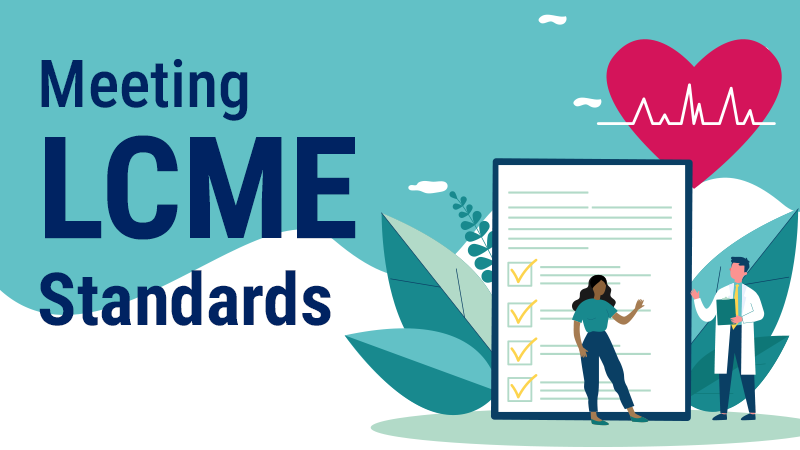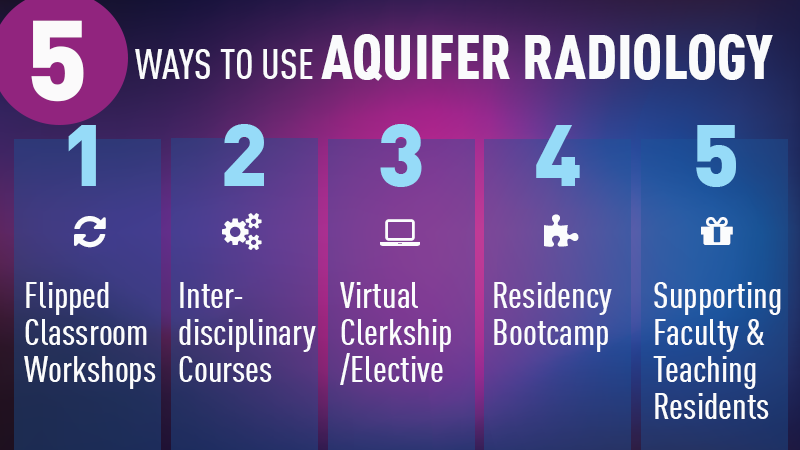Meeting the requirements for continuous accreditation of the educational program is a core focus for medical schools. Currently serving 96% of US allopathic medical schools, Aquifer is a trusted tool in medical education. Aquifer’s teaching and learning tools help medical schools of all shapes and sizes meet many of the Liaison Committee on Medical Education (LCME) Standards.
LCME 6.2 Required Clinical Experiences and 8.6 Monitoring of Completion of Required Clinical Experiences
6.2: “The faculty of a medical school ensure that the medical curriculum includes self-directed learning experiences and unscheduled time to allow medical students to develop the skills of lifelong learning. Self-directed learning involves medical students’ self-assessment of learning needs; independent identification, analysis, and synthesis of relevant information; appraisal of the credibility of information sources; and feedback on these skills.”
8.6: “A medical school has in place a system with central oversight that monitors and ensures completion by all medical students of required clinical experiences in the medical education program and remedies any identified gaps.”
HOW AQUIFER HELPS
Enhancing the Range of Clinical Encounters
In addition to caring for patients, LCME considers Aquifer cases an acceptable clinical learning experience. However, if the cases are to “count,” students should be given independent learning time to work through them, and the content of the cases should be integrated into the clerkship curriculum in methods similar to patient care (i.e., didactics, bedside teaching, discussion, etc.).
There are numerous ways to classify the spectrum of patients to be seen. With the Aquifer Content Library, it’s easy to search cases to find the content you need and assign it to students. For example, filters can cover:
- Ages/developmental stages
- Types of illnesses
- Systems-based categories

Suggested methods for assigning cases include:
- Assign strategically selected cases at the beginning of the clerkship to:
- prepare students to see patients with conditions they are likely to encounter
- fill known clinical gaps
- Assign cases individually throughout the clerkship, based on a review of each student’s clinical logs.
- A combination of both.
Documentation Method
Aquifer automatically creates a log of students’ completion of virtual patient cases. The Student Report, only accessible to people with specific administrative privileges in Aqueduct’s platform, shows the detailed progress of an individual student in each case in a course, including:
- The cases the student has completed, partially completed, or not yet not begun
- Time from case start to completion
- Additional details on the date the case was started, completed, and last accessed
- Summary Statements submitted by students for cases that require them
LCME 8.7 Comparability of Education/Assessment
A medical school ensures that the medical curriculum includes comparable educational experiences and equivalent methods of assessment across all locations within a given course and clerkship to ensure that all medical students achieve the same medical education program objectives.
HOW AQUIFER HELPS
Aquifer cases provide comparable learning experiences across training sites and times of year, standardizing the availability of patients and key conditions. Because the cases are available both online and offline via our iOS and Android apps, students have access to them from all training sites, facilitating student placement in rural or community settings.
LCME 7.2 Organ Systems/Life Cycle/Primary Care/Prevention
The faculty of a medical school ensure that the medical curriculum includes content and clinical experiences related to each organ system; each phase of the human life cycle; continuity of care; and preventive, acute, chronic, rehabilitative, and end-of-life care.
HOW AQUIFER HELPS
Aquifer courses provide practice with virtual patients at all stages, from birth, through childhood and adulthood, to end of life. With courses in Pediatrics, Family Medicine, Internal Medicine, Geriatrics, Radiology, and Palliative Care, Aquifer covers the full continuum of care.
Several virtual patient cases address wellness and preventive care (including Family Medicine Cases 1&2, Pediatrics Cases 2, 3, 4, 5 & 6, Internal Medicine Cases 13,14), and Geriatrics Case 13 ). Other cases provide students the opportunity to practice clinical reasoning for common medical conditions, including interpreting abnormal clinical findings, developing differential diagnoses, selecting appropriate diagnostic tests, and developing treatment plans. Rather than providing rote, depersonalized clinical data, Aquifer virtual patients are deliberately designed to illustrate a variety of socioeconomic backgrounds in order to teach students how biopsychosocial factors interact to impact patients’ health.
LCME 7.4 Critical Judgment/Problem-Solving Skills
The faculty of a medical school ensure that the medical curriculum incorporates the fundamental principles of medicine, provides opportunities for medical students to acquire skills of critical judgment based on evidence and experience, and develops medical students’ ability to use those principles and skills effectively in solving problems of health and disease.
HOW AQUIFER HELPS
Aquifer patient cases are evidence-based, include references to supporting literature, and are peer-reviewed. They provide students multiple opportunities to practice evidence-based clinical problem solving through embedded questions and receive expert feedback on their work through answer comments and teaching points. In most cases, students practice differential diagnoses, critical thinking, and evidence appraisal. Many cases require students to synthesize the information and write a summary statement.
Additional teaching tools, designed to accompany the cases, can enhance these skills as well, including:
- Case Analysis Tool (a structured worksheet to be completed by the student as they work through an Aquifer case, allowing faculty to provide feedback on clinical reasoning skills).
- Other active learning sessions were created to accompany Aquifer cases and further support this aspect of critical judgment.
Aquifer also offers the Internal Medicine Clinical Decision-Making Exam, which provides the unique ability to assess students’ individual abilities to apply their knowledge to make the decisions needed to provide quality patient care.
LCME 7.6 Cultural Competence & Health Care Disparities
The faculty of a medical school ensure that the medical curriculum provides opportunities for medical students to learn to recognize and appropriately address biases in themselves, in others, and in the health care delivery process. The medical curriculum includes content regarding the following:
- The diverse manner in which people perceive health and illness and respond to various symptoms, diseases, and treatments
- The basic principles of culturally competent health care
- Recognition of the impact of disparities in health care on all populations and potential methods to eliminate health care disparities
- The knowledge, skills, and core professional attributes needed to provide effective care in a multidimensional and diverse society
HOW AQUIFER HELPS
Following a thorough review of all existing Aquifer cases according to our peer-reviewed and published criteria (Academic Medicine), our cases continue to be regularly reviewed based on these principles by teams of medical educators to ensure that current best practices are consistently integrated across our content library.
Aquifer’s three Social Determinants of Health Cases and accompanying active learning modules build a foundational understanding of SDOH and teach evidence-based strategies to help improve health outcomes and equity for patients. The overview and resources module provides an understanding of how cultural beliefs and community culture affect health outcomes and strategies for improving clinician-patient interactions. The two virtual patient cases provide an opportunity for students to learn in the context of a realistic patient scenario and practice the application of the information in a safe space, working through patient and family interactions, and practice using the tools when caring for a patient.
Aquifer Diagnostic Excellence cases include teaching on cognitive bias, with supporting active learning sessions to drive discussions and enhance the learning through sharing experiences.
LCME 7.5 – Societal Problems
The faculty of a medical school ensure that the medical curriculum includes instruction in the diagnosis, prevention, appropriate reporting, and treatment of the medical consequences of common societal problems.
HOW AQUIFER HELPS
The Course on Addiction and Recovery Education (CARE) – distributed by Aquifer on behalf of the Hazelden Betty Ford Foundation – concentrates on critical addiction and substance use topics that medical students and healthcare professionals need to be able to address. CARE prepares students to identify, intervene, and address substance use disorders, filling a critical gap in formal education surrounding substance use disorders and addiction.
Aquifer’s Social Determinants of Health course includes teaching on the core principles, as well as two application cases that cover poverty and language as social determinants of health and teach evidence-based strategies to help improve health outcomes and equity for patients.
The cases in Aquifer Trauma-Informed Care address a range of core competencies and critical learning objectives, including the prevalence and health effects of trauma, the principles of trauma-informed care, the neurobiology of trauma, clinical management of persons who have experienced traumatic events, and interprofessional collaboration methods for working with trauma-affected patients.
Additional teaching that meets this qualification is also found throughout the Aquifer signature cases.
7.1 – Biomedical, Behavioral, Social Sciences
The faculty of a medical school ensure that the medical curriculum includes content from the biomedical, behavioral, and socioeconomic sciences to support medical students’ mastery of contemporary medical science knowledge and concepts and the methods fundamental to applying them to the health of individuals and populations.
HOW AQUIFER HELPS
Integrated Illness Scripts are designed specifically to promote cognitive integration and provide a framework for learners to link basic science and clinical knowledge. Building on the traditional illness script format, Integrated Illness Scripts (IIS) embed basic science core concepts and causal mechanisms within each clinical feature and display the connections visually through Mechanism of Disease Maps. A variety of rich, fully-developed active learning sessions are available to accompany Integrated Illness Scripts to extend the learning to case-based learning or other didactic sessions.
The Aquifer Sciences Curriculum is the first nationally-developed and publicly available curriculum that comprehensively outlines the core basic sciences concepts that must be understood and mastered by health professions learners in order to provide safe, routine patient care. The Curriculum is freely available and provides an ideal tool for those undergoing curricular planning.
9.7 – Formative Assessment and Feedback
The faculty of a medical school ensure that the medical curriculum includes self-directed learning experiences and unscheduled time to allow medical students to develop the skills of lifelong learning. Self-directed learning involves medical students’ self-assessment of learning needs; independent identification, analysis, and synthesis of relevant information; appraisal of the credibility of information sources; and feedback on these skills.
HOW AQUIFER HELPS
Aquifer has a variety of tools that support formative feedback.
Many cases require students to write a summary statement, which is visible in faculty reports alongside an expert comment, providing an opportunity for faculty to provide feedback on developing clinical communication skills.
Aquifer’s Case Analysis Tool (CAT) is a structured worksheet to be completed by the student as they work through an Aquifer case, designed to enhance the development of clinical reasoning skills. She notes how the CAT helps students by walking them through each step of the Aquifer case and aiding in organizing their critical thinking. By using it in conjunction with Aquifer cases, it helps students better explain their decision-making and learn to navigate clinical situations independently. The CAT can be used as a graded assignment, or to provide formative feedback to students.
6.3 – Self-Directed and Life-Long Learning
The faculty of a medical school ensure that the medical curriculum includes self-directed learning experiences and unscheduled time to allow medical students to develop the skills of lifelong learning. Self-directed learning involves medical students’ self-assessment of learning needs; independent identification, analysis, and synthesis of relevant information; appraisal of the credibility of information sources; and feedback on these skills.
HOW AQUIFER HELPS
Calibrate, Aquifer’s formative assessment system for clinical learning, drives self-directed learning by providing detailed feedback early (and late) in the clerkship to enable targeted study planning. This assessment system provides guidance for students to create a learning plan early in their clerkship, and objective information about individual learners to drive meaningful feedback and inform coaching conversations.
Aquifer cases also contain self-assessment questions, helping students extend their learning beyond the case into new, related scenarios.
9.1 – Preparation of Resident and Non-faculty Instructors
In a medical school, residents, graduate students, postdoctoral fellows, and other non-faculty instructors in the medical education program who supervise or teach medical students are familiar with the learning objectives of the course or clerkship and are prepared for their roles in teaching and assessment. The medical school provides resources to enhance residents’ and non-faculty instructors’ teaching and assessment skills and provides central monitoring of their participation in those opportunities.
HOW AQUIFER HELPS
Each Aquifer case is written from the medical student perspective and includes details that model communication with preceptors and patients, providing invaluable “scripts” and guidance on interacting with students for new teachers.
Cases are available to teaching residents and preceptors at no cost to the school allowing them to provide access to preceptors and other teaching clinicians in a FERPA-compliant way (no access to student reporting – known as the “Teacher” role in the Aquifer platform).
Educator Resources such as the Radiology Flipped Classroom modules and the many active learning sessions that accompany other courses make it easy for teachers to provide a quality didactic experience by providing fully-developed sessions and facilitator guides.
4.5 – Faculty Professional Development
A medical school and/or its sponsoring institution provides opportunities for professional development to each faculty member in the areas of discipline content, curricular design, program evaluation, student assessment methods, instructional methodology, and research to enhance his or her skills and leadership abilities in these areas.
HOW AQUIFER HELPS
Aquifer regularly offers free webinars designed to highlight important concepts in medical education with practical tips from national experts. Aquifer webshops are highly interactive virtual workshops that deliver deep engagement with expert faculty around innovative new teaching and learning tools and methods. Faculty receive confirmation of attendance and learning objectives for all sessions.



